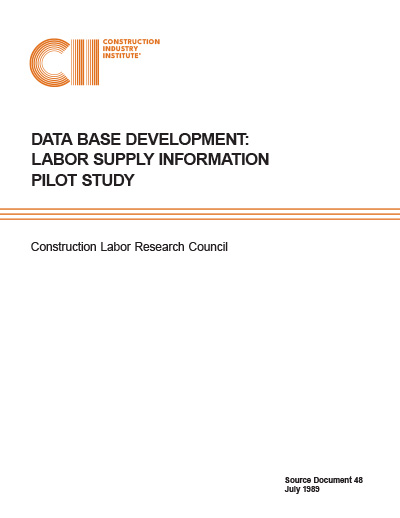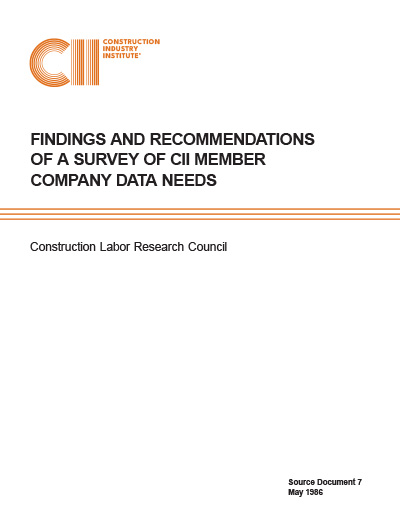
Database Development, Labor Supply Information Pilot Study
Obtaining reliable estimates of future labor supply has been difficult, especially in the construction industry, with little attention having been given to the topic. Information as to the available long-term supply of labor has been scant and the information which has been available has been of questionable value. With labor generally available and mobile in recent years, labor supply information has been a low priority issue, but changes in the composition of the work force in the United States in recent years suggest skilled construction workers will become a scarcer industry resource.
Demographics in the United States will make the next decade unique in the second half of this century. The number of 18 to 24 year olds, the prime source of new entrants into the labor force, will be declining. Groups that will be increasing in numbers, primarily older women and minorities, have traditionally not accounted for a large portion of the construction work force. The reduced number of 18 to 24 year olds will impact all industries, but, as the nation’s largest industry, the construction industry will be especially vulnerable. Construction labor is likely to be in short supply, but because of demographics not construction volume.
Most of the demand for new construction workers in the next decade will be to replace those persons now in the industry who leave. A stable number of workers will be retiring, dying or otherwise leaving the industry during this period in which the younger entrants are declining. Industry growth is projected to be modest so that demand for workers to meet replacement needs will account for over two-thirds of the total need for new workers.
The framework for examining labor supply information issues was developed in The Business Roundtable’s Construction Industry Cost Effectiveness project. Task Force Report D-5, Labor Supply Information, called for undertaking a pilot study “to determine whether (labor supply) data can be presented in a format that is satisfactory for industrial construction planning and, if so, whether users and contractors will use it.” Because of high construction unemployment levels at the time the study was released, there had been no implementation efforts.
The purpose of this project has been to review all available sources in order to develop a data base of information which can be utilized by the industry to identify long-term labor supply needs. Since construction labor needs are localized by occupation, the project stressed information at this level of detail. A single state, Ohio, was selected in which to perform this pilot study. While the bulk of the project consisted of data collection, review and analysis, a key segment of the work was a presentation to owners and contractors in Ohio of the findings. Data were developed and presented for major occupations in eight metropolitan areas.
Of all the data examined, three types were found to be most useful in quantifying the industry’s local labor supply situation—labor force inventory, projections, and demographics. For each of these, information exists, it is useful, and it can be improved in content and format. All is generated by government statistical agencies.
The labor force inventory is a compilation of the number of persons working in the construction industry by occupation. These data are collected every three years in a survey of employers with the most recent survey covering May 1987. This is the best means of determining the occupational composition of the industry and is an accurate benchmark from which to estimate future needs. All states have statewide tabulations, but Ohio is one of the few with sub-state breakdowns.
The projections are estimates of future period employment and the number of openings that will need to be filled to achieve the projected employment levels. Openings are divided into growth and replacement needs. The methodology used to develop these projections results in conservative estimates of labor needs. These data are valuable in determining the number of new workers to be trained, but the need for better separation rates to estimate replacement needs is critical. Application of these data in Ohio was evaluated.
The importance of replacement needs places an emphasis upon demographic data. Information on the number of workers by age, occupation and city is available in Ohio and all other states. It was probably very accurate when it was collected in the 1980 Census, but its value has diminished over time. It remains the best available source for determining the number of older workers to be replaced.
The labor supply information available in Ohio is representative of that available everywhere except that a greater amount of sub-state detail is available in Ohio. Ohio’s efforts illustrate the potential of labor supply information and are an example for other states to emulate. Analysis of Ohio data also identified data bases that could be improved.
The workshop for Ohio owners and contractors exposed those who would be the primary users of the information to the project findings. There was good interest in the topic and the findings. The workshop also demonstrated that, in the data’s present format, persons in the industry will need help in utilizing the available material—formats and presentation need to be improved.
The Construction Industry Institute has led the industry in examining labor supply information issues. It can continue to provide this leadership by assisting others in performing studies similar to Ohio’s (but generally not performing them itself) and by endorsing improvements in government statistical programs. CII can best assist others by preparing a non-technical instruction booklet for others to use in examining labor supply issues. Improvements in government data can be achieved by a credible organization like CII working for better data presentation (a short-term, minimal cost-to-government objective) and improved data sources (a long-term, higher cost-to-government objective).
Through this project CII has made an important contribution toward a better understanding of the labor supply issues that will be faced by the construction industry in the next decade and demonstrated that the data tools exist to quantify the issue at the local level.


